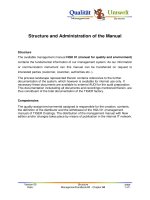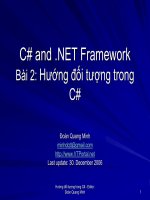Tài liệu Designing and Developing Scalable IP Networks docx
Bạn đang xem bản rút gọn của tài liệu. Xem và tải ngay bản đầy đủ của tài liệu tại đây (2.81 MB, 305 trang )
Designing and Developing
Scalable IP Networks
Guy Davies
Telindus, UK
Designing and Developing
Scalable IP Networks
Designing and Developing
Scalable IP Networks
Guy Davies
Telindus, UK
Copyright 2004 Guy Davies
Published 2004 by John Wiley & Sons Ltd, The Atrium, Southern Gate, Chichester,
West Sussex PO19 8SQ, England
Telephone (+44) 1243 779777
Email (for orders and customer service enquiries):
Visit our Home Page on www.wileyeurope.com or www.wiley.com
All Rights Reserved. No part of this publication may be reproduced, stored in a retrieval system or
transmitted in any form or by any means, electronic, mechanical, photocopying, recording, scanning or
otherwise, except under the terms of the Copyright, Designs and Patents Act 1988 or under the terms of a
licence issued by the Copyright Licensing Agency Ltd, 90 Tottenham Court Road, London W1T 4LP, UK,
without the permission in writing of the Publisher. Requests to the Publisher should be addressed to the
Permissions Department, John Wiley & Sons Ltd, The Atrium, Southern Gate, Chichester, West Sussex PO19
8SQ, England, or emailed to , or faxed to (+44) 1243 770620.
This publication is designed to provide accurate and authoritative information in regard to the subject matter
covered. It is sold on the understanding that the Publisher is not engaged in rendering professional services. If
professional advice or other expert assistance is required, the services of a competent professional should be
sought.
Other Wiley Editorial Offices
John Wiley & Sons Inc., 111 River Street, Hoboken, NJ 07030, USA
Jossey-Bass, 989 Market Street, San Francisco, CA 94103-1741, USA
Wiley-VCH Verlag GmbH, Boschstr. 12, D-69469 Weinheim, Germany
John Wiley & Sons Australia Ltd, 33 Park Road, Milton, Queensland 4064, Australia
John Wiley & Sons (Asia) Pte Ltd, 2 Clementi Loop #02-01, Jin Xing Distripark, Singapore 129809
John Wiley & Sons Canada Ltd, 22 Worcester Road, Etobicoke, Ontario, Canada M9W 1L1
Wiley also publishes its books in a variety of electronic formats. Some content that appears
in print may not be available in electronic books.
Library of Congress Cataloging-in-Publication Data
Davies, Guy.
Designing & developing scalable IP networks / Guy Davies.
p. cm.
Includes bibliographical references and index.
ISBN 0-470-86739-6 (cloth : alk. paper)
1. Computer networks—Design and construction. 2. Computer
networks—Scalability. I. Title: Designing and developing scalable
IP networks. II. Title.
TK5105.5.D3794 2004
004.6
2—dc22
2004011563
British Library Cataloguing in Publication Data
A catalogue record for this book is available from the British Library
ISBN 0-470-86739-6
Typeset in 10/12pt Times by Laserwords Private Limited, Chennai, India
Printed and bound in Great Britain by Antony Rowe Ltd, Chippenham, Wiltshire
This book is printed on acid-free paper responsibly manufactured from sustainable forestry
in which at least two trees are planted for each one used for paper production.
Contents
List of Figures xi
List of Tables xiii
About the Author xv
Acknowledgements xvii
Abbreviations xix
Introduction xxv
1 Hardware Design 1
1.1 Separation of Routing and Forwarding Functionality 2
1.2 Building Blocks 2
1.2.1 Control Module 3
1.2.2 Forwarding Module 3
1.2.3 Non-Stop Forwarding 3
1.2.4 Stateful Failover 3
1.3 To Flow or Not to Flow? 4
1.4 Hardware Redundancy, Single Chassis or Multi Chassis 5
2 Transport Media 7
2.1 Maximum Transmission Unit (MTU) 7
2.1.1 Path MTU Discovery 8
2.1.2 Port Density 8
2.1.3 Channelized Interfaces 9
vi CONTENTS
2.2 Ethernet 9
2.2.1 Address Resolution Protocol (ARP) 10
2.2.2 MTU 11
2.3 Asynchronous Transfer Mode (ATM) 11
2.4 Packet Over SONET (POS) 13
2.5 SRP/RPR and DPT 13
2.5.1 Intelligent Protection Switching 15
2.6 (Fractional) E1/T1/E3/T3 16
2.7 Wireless Transport 17
2.7.1 Regulatory Constraints 17
2.7.2 Interference 17
2.7.3 Obstructions 17
2.7.4 Atmospheric Conditions 18
2.7.5 If it is so bad 18
3 Router and Network Management 21
3.1 The Importance of an Out-Of-Band (OOB) Network 21
3.1.1 Management Ethernet 22
3.1.2 Console Port 22
3.1.3 Auxiliary (Aux) Port 22
3.1.4 Remote Power Management 23
3.1.5 Uninterruptible Power Supplies (UPS) 23
3.2 Network Time Protocol (NTP) 23
3.3 Logging 24
3.4 Simple Network Management Protocol (SNMP) 24
3.4.1 SNMPv1, v2c and v3 25
3.5 Remote Monitoring (RMON) 26
3.6 Network Management Systems 26
3.6.1 CiscoWorks 26
3.6.2 JUNOScope 27
3.6.3 Non-Proprietary Systems 27
3.7 Configuration Management 27
3.7.1 Concurrent Version System (CVS) 27
3.7.2 Scripting and Other Automated Configuration Distribution and
Storage Mechanisms 28
3.8 To Upgrade or Not to Upgrade 31
3.8.1 Software Release Cycles 32
3.9 Capacity Planning Techniques 32
4 Network Security 35
4.1 Securing Access to Your Network Devices 35
4.1.1 Physical Security 36
4.1.2 Authentication, Authorization and Accounting (AAA) 36
CONTENTS vii
4.2 Securing Access to the Network Infrastructure 40
4.2.1 Authentication of Users, Hosts and Servers 40
4.2.2 Encryption of Information 40
4.2.3 Access Tools and Protocols 41
4.2.4 IP Security (IPsec) 43
4.2.5 Access Control Lists 44
4.2.6 RFC 1918 Addresses 45
4.2.7 Preventing and Tracing Denial of Service (DoS) Attacks 46
4.3 Protecting Your Own and Others’ Network Devices 47
5 Routing Protocols 49
5.1 Why Different Routing Protocols? 50
5.2 Interior Gateway Protocols (IGP) 50
5.2.1 Open Shortest Path First (OSPF) 51
5.2.2 Authentication of OSPF 53
5.2.3 Stub Areas, Not So Stubby Areas (NSSA) and Totally Stubby
Areas 54
5.2.4 OSPF Graceful Restart 55
5.2.5 OSPFv3 56
5.2.6 Intermediate System to Intermediate System (IS-IS) 56
5.2.7 Authentication of IS-IS 57
5.2.8 IS-IS Graceful Restart 58
5.2.9 Routing Information Protocol (RIP) 58
5.2.10 Interior Gateway Routing Protocol (IGRP) and Enhanced Interior
Gateway Routing Protocol (EIGRP) 59
5.2.11 Diffusing Update Algorithm (DUAL) 61
5.2.12 Stuck-in-Active 62
5.2.13 Why use EIGRP? 62
5.3 Exterior Protocols 63
5.3.1 Border Gateway Protocol (BGP) 63
5.3.2 Authentication of BGP 67
5.3.3 BGP Graceful Restart 68
5.3.4 Multiprotocol BGP 69
6 Routing Policy 71
6.1 What is Policy For? 71
6.1.1 Who Pays Whom? 72
6.2 Implementing Scalable Routing Policies 72
6.3 How is Policy Evaluated? 73
6.3.1 AND or OR? 73
6.3.2 The Flow of Policy Evaluation 73
6.4 Policy Matches 74
6.5 Policy Actions 74
viii CONTENTS
6.5.1 The Default Action 74
6.5.2 Accept/Permit, Reject/Deny, and Discard 74
6.6 Policy Elements 75
6.7 AS Paths 75
6.8 Prefix Lists and Route Lists 75
6.9 Internet Routing Registries 77
6.10 Communities 78
6.11 Multi-Exit Discriminator (MED) 80
6.12 Local Preference 80
6.13 Damping 81
6.14 Unicast Reverse Path Forwarding 83
6.15 Policy Routing/Filter-Based Forwarding 84
6.16 Policy Recommendations 84
6.16.1 Policy Recommendations for Customer Connections 84
6.16.2 Policy Recommendations for Peering Connections 85
6.16.3 Policy Recommendations for Transit Connections 85
6.17 Side Effects of Policy 91
7 Multiprotocol Label Switching (MPLS) 97
7.1 Traffic Engineering 98
7.2 Label Distribution Protocols 99
7.3 Tag Distribution Protocol (TDP) 100
7.4 Label Distribution Protocol (LDP) 100
7.4.1 LDP Graceful Restart 101
7.5 RSVP with Traffic Engineering Extensions (RSVP-TE) 101
7.5.1 RSVP-TE Graceful Restart 102
7.5.2 OSPF with Traffic Engineering Extensions (OSPF-TE) 102
7.5.3 IS-IS with Traffic Engineering Extensions (IS-IS-TE) 102
7.6 Fast Reroute 103
7.7 Integrating ATM and IP Networks 104
7.8 Generalized MPLS (GMPLS) 105
8 Virtual Private Networks (VPNs) 109
8.1 VPNs at Layer 3 109
8.1.1 Layer 3 VPN (RFC 2547bis) 109
8.1.2 Generic Router Encapsulation (GRE) 111
8.1.3 IPsec 112
8.2 VPNs at Layer 2 112
8.2.1 Circuit Cross-Connect (CCC) 112
8.2.2 Translational Cross-Connect (TCC) 113
8.2.3 Martini (Layer 2 circuits) 113
8.2.4 Virtual Private Wire Service (VPWS) 114
8.2.5 Virtual Private LAN Service (VPLS) 116
8.2.6 Layer 2 Tunnelling Protocol (L2TP) 117
CONTENTS ix
9 Class of Service and Quality of Service 119
9.1 Design and Architectural Issues of CoS/QoS 119
9.2 CoS/QoS Functional Elements 120
9.2.1 Classification 120
9.2.2 Congestion Notification Mechanisms 121
9.2.3 Congestion Avoidance Mechanisms 122
9.2.4 Queueing Strategies 124
9.3 QoS Marking Mechanisms 127
9.3.1 Layer 2 Marking 128
9.3.2 Layer 3 QoS 129
9.3.3 MPLS EXP 130
9.4 Integrating QoS at Layer 2, in IP and in MPLS 130
9.4.1 DiffServ Integration with MPLS 131
10 Multicast 133
10.1 Multicast Forwarding at Layer 2 133
10.1.1 Multicast on Ethernet and FDDI 134
10.1.2 Multicast Over Token Ring 134
10.1.3 Internet Group Management Protocol (IGMP) 135
10.1.4 IGMP Snooping 136
10.1.5 PIM/DVMRP Snooping 136
10.1.6 Immediate Leave Processing 137
10.1.7 Cisco Group Management Protocol (CGMP) 137
10.2 Multicast Routing 138
10.2.1 Reverse Path Forwarding (RPF) Check 138
10.2.2 Dense Mode Protocols 138
10.2.3 Sparse Mode Protocols 143
10.2.4 Multicast Source Discovery Protocol (MSDP) 148
10.2.5 Multiprotocol BGP 149
10.2.6 Multicast Scoping 149
11 IPv6 153
11.1 Evolution and Revolution 153
11.2 IPv6 Headers 154
11.3 IPv6 Addressing 154
11.3.1 Hierarchical Allocations 155
11.3.2 Address Classes 157
11.4 Stateless Autoconfiguration 158
11.5 Domain Name System (DNS) 158
11.6 Transition Mechanisms 159
11.6.1 Dual Stack 159
11.6.2 Network Address Translation—Protocol Translation 159
11.6.3 Tunnelling IPv6 in IPv4 160
x CONTENTS
11.7 Routing in IPv6 161
11.7.1 IS-IS for IPv6 161
11.7.2 OSPFv3 161
11.7.3 RIPng 161
11.7.4 Multiprotocol BGP 162
11.8 Multicast in IPv6 162
11.9 IPv6 Security 162
11.10 Mobility in IPv6 163
12 Complete Example Configuration Files (IOS and JUNOS Software) 165
12.1 Core Router (P) Running MPLS TE Supporting LDP Tunnelled Through
RSVP-TE, No Edge Interfaces, iBGP Only, Multicast RP (Anycast
Static) MSDP, PIM-SM (JUNOS) 166
12.2 Core Router (P) Running MPLS TE Supporting LDP Tunnelled Through
RSVP-TE, No Edge Interfaces, iBGP Only, Multicast RP (Anycast
Static) MSDP, PIM-SM (IOS) 183
12.3 Aggregation Router (PE) Running MPLS L3 and L2VPN Over LDP,
BGP Policy to Customers, MBGP, PIM-SM (JUNOS) 192
12.4 Aggregation Router (PE) Running MPLS L3 and L2VPN Over LDP,
BGP Policy to Customers, MBGP, PIM-SM (IOS) 213
12.5 Border Router Running MPLS with LDP, BGP Policy to Peers, MBGP,
PIM-SM (JUNOS) 222
12.6 Border Router Running MPLS with LDP, BGP Policy to Peers, MBGP,
PIM-SM (IOS) 236
12.7 Transit Router Running MPLS with LDP, BGP Policy to Upstream
Transit Providers, MBGP, PIM-SM (JUNOS) 242
12.8 Transit Router Running MPLS with LDP, BGP Policy to Upstream
Transit Providers, MBGP, PIM-SM (IOS) 257
References 263
Index 265
List of Figures
1.1 The logical architecture of an IP router (separate forwarding and
routing planes)
2.1 Overhead associated with the transport of IP packets in ATM cells
2.2 Intact SRP dual counter rotating rings
2.3 Both fibres cut at a single point, ring wrapped at adjacent nodes
2.4 Node lost, ring wrapped at adjacent nodes
4.1 Security Associations unidirectional
5.1 Multi-area OSPF hierarchy
5.2 Illegal OSPF hierarchy
5.3 A virtual link makes this hierarchy legal
5.4 Route reflection
5.5 BGP confederations
6.1 Example network for persistent oscillation
7.1 MPLS label
7.2 Traffic engineering with MPLS
7.3 MPLS fast reroute, link protection
7.4 MPLS fast reroute, node protection
7.5 Integrating MPLS and ATM networks
7.6 Integrating MPLS and Optical switches with GMPLS
8.1 MPLS Layer 3 VPN example
8.2 MPLS Layer 3 VPN example using route reflection
8.3 VPLS example
9.1 Global TCP synchronization
9.2 Output with RED applied
9.3 Stepped weighted RED parameters
9.4 Weighted queueing schedulers
9.5 The IP Type of Service Byte
9.6 The DiffServ Code Point
xii LIST OF FIGURES
10.1 Example multicast network
10.2 Example of the limitations of TTL-based multicast scoping
11.1 Original format of the globally aggregatable unicast addressing scheme
11.2 Newer format of the globally aggregatable unicast addressing scheme
List of Tables
3.1 Expect script to delete MPLS traffic engineering configuration from a Juniper
router
3.2 Perl script to delete MPLS traffic engineering configuration from a Juniper
router
6.1 Comparison of verbose and terse configuration style
6.2 JUNOS and IOS BGP policy configuration format
6.3 JUNOS prefix list.
6.4 IOS prefix list
6.5 JUNOS firewall filters
6.6 IOS access lists
6.7 Using BGP communities with JUNOS and IOS
6.8 Configuring BGP route flap damping with JUNOS and IOS
6.9 Limited sample BGP configuration to customers using JUNOS and IOS
6.10 Limited sample BGP configurations to peers using JUNOS and IOS
6.11 Limited sample BGP configurations to transit providers using JUNOS and
IOS
6.12 Initial routing state in cluster 1
6.13 Initial routing state in cluster 2
6.14 Modified routing state in cluster 1
6.15 Modified routing state in cluster 2
6.16 Comparison of the active route selection processes in JUNOS and IOS
7.1 IOS configuration to constrain LDP advertisements to loopback0 only
9.1 Mappings from IP ToS bits settings to output queuers using four output
queues
About the Author
Guy Davies has worked as an IP Architect for Telindus, a network integrator in the
UK, for four years. While at Telindus, he has been involved in many projects ranging
from the design, implementation and operation of customers’ core IP networks through
to migration of ATM networks to an IP and MPLS-based infrastructure, and the design
and implementation of large secured wireless networks and consultancy as well as the
development of wireless rural broadband access. During this time, he has also worked as
a contractor to Juniper Networks, providing engineering and consulting services both in
the UK and overseas.
Prior to Telindus, Guy spent five years working for UUNET (and its previous incarna-
tion in the UK, PIPEX). During his time at PIPEX and UUNET, Guy worked in a variety
of engineering and management roles including systems administration, network opera-
tion and development roles. He was responsible for the design of the first pan-European
MPLS core network built by UUNET.
Guy is JNCIE #20 and is also a CCIP.
BIOGRAPHY OF REVIEWER
Todd M. Regonini has almost ten years of industry experience in IP network design, imple-
mentation, and administration. He is currently employed as a Senior Systems Engineer
working for Juniper Networks in Sunnyvale, California. Prior to that he worked for Cisco
Systems where he consulted directly with customers on the design and implementation
of IP networks. Todd is Juniper Networks Certified Internet Expert (JNCIE) #23.
Acknowledgements
This book has just one author. Despite that, it is only through the efforts of a number of
people that this book has now been published.
I would first of all like to thank Patrick Ames. It was he who convinced me to write
this book in the first place. Then, having got me to put my ideas down, it was he who
helped me find a publisher for my work and he who kept me going, even when I doubted
my own ability to complete the project. Without a doubt, this book would not have seen
the light of day but for him.
Throughout the writing process, I have received corrections and advice from an array
of friends and colleagues. Several engineers and consultants at Juniper Networks provided
significant input. Particular thanks go to Aviva Garrett, Paul Goyette, Pete Moyer, Bill
Nowak and Todd Regonini, who all provided invaluable technical information. I thank my
former colleagues at UUNET, Tony Barber and John Whyte, for their thorough technical
review and discussion of various issues covered in the book. I’d also like to thank Danny
McPherson, who provided some useful insight into several issues surrounding BGP and
the selection of parameters for policy. In addition to the technical reviewers above, Cressi
Whyte gave some extremely useful advice on writing style.
I also received great help from Richard Southern of Juniper TAC in checking the config-
urations at the end of this book. I greatly appreciate the help he gave me at exceptionally
short notice. Despite the time constraints, his work was thorough and accurate.
I would also like to thank the editing team at John Wiley & Sons, Ltd: Sally Mortimore,
Birgit Gruber, Daniel Gill, Susan Dunsmore and Lucy Bryan.
Finally, I would especially like to thank my wife, Ghillie, and my children, Emily and
George, for their endless patience. This book has taken much of my free time and most
evenings for several months. I am sorry I have not paid as much attention to you or spent
as much time with you as I should have done.
Abbreviations
AAA Authorization, Authentication and Accounting
AAL ATM Adaption Layer
ABR Area Border Router
ABR Available Bit Rate
AES Advanced Encryption Standard
AH Authentication Headers
APS Automatic Protection Switching
ARP Address Resolution Protocol
AS Autonomous System
ASIC Application Specific Integrated Circuit
ASM Any Source Multicast
ATM Asynchronous Transfer Mode
BA Behaviour Aggregate
BECN Backward Explicit Congestion Notification
BFWA Broadband Fixed Wireless Access
BGP Border Gateway Protocol
BSR Bootstrap Router
CA Certificate Authority
CBR Constant Bit Rate
C-BSR Candidate Bootstrap Router
CCC Circuit Cross Connect
CE Customer Edge LSR/Router
CGMP Cisco Group Management Protocol
CIDR Classless Inter-Domain Routing
CLI Command Line Interface
CLNP Connectionless Network Protocol
CoS Class of Service
CPU Central Processor Unit
xx ABBREVIATIONS
C-RP Candidate Rendezvous Point
CSMA-CD Carrier Sense Multiple Access-Collision Detection
CSPF Constrained Shortest Path First
CVS Concurrent Version System
DCE Data Communication Equipment
DCN Data Control Network
DE Discard Eligible
DNS Domain Name System
DoS Denial of Service
DPT Dynamic Packet Transport
DR Designated Router
DRR Deficit Round Robin
DSCP DiffServ Code Point
DTE Data Terminating Equipment
DUAL Diffusing Update Algorithm
DVMRP Distance Vector Multicast Routing Protocol
DWDM Dense Wavelength Division Multiplexing
EAP Extensible Authentication Protocol
ECN Explicit Congestion Notification
ECT ECN Capable Transport
EIGRP Enhanced Interior Gateway Routing Protocol
E-LSP Diffserv integrated LSP using EXP bits to represent DSCP
ESP Encapsulating Security Payload
EXP MPLS Experimental Bits
FC Feasibility Condition
FD Feasibility Distance
FEC Forwarding Equivalence Class
FECN Forward Explicit Congestion Notification
FSC Fibre Switched Capable
FT Fault Tolerant TLV
FTP File Transfer Protocol
GDA Group Destination Address
GMPLS Generalized Multiprotocol Label Switching
GPRS General Packet Radio Service
GPS Generalized Packet Scheduler
GRE Generic Router Encapsulation
ICMP Internet Control Message Protocol
IEEE Institute of Electrical and Electronic Engineers
IETF Internet Engineering Task Force
IGMP Internet Group Management Protocol
IGP Interior Gateway Protocol
IGRP Interior Gateway Routing Protocol
IIH IS-IS Hello PDU
IP Internet Protocol
ABBREVIATIONS xxi
IPS Intelligent Protection Switching
IRR Internet Routing Registry
IS Intermediate System
IS-IS Intermediate System to Intermediate System
ISO International Organization for Standardization
IXP Internet Exchange Point
L2TP Layer 2 Tunneling Protocol
LDP Label Distribution Protocol
LIR Local Internet Registry
L-LSP Diffserv integrated LSP using labels to represent different DSCP
LOL Loss Of Light
LOS Loss Of Signal
LSA Link State Advertisement
LSC Lambda Switched Capable
LSDB Link State Database
LSP Label Switched Path (MPLS)
LSP Link State PDU (IS-IS)
LSR Label Switching Router
MAC Media Access Control
MBGP Multiprotocol Border Gateway Protocol
MD5 Message Digest 5
MED Multi-Exit Discriminator
MIB Management Information Base
MPLS Multiprotocol Label Switching
MRU Maximum Receive Unit
MSDP Multicast Source Discovery Protocol
MSP Multiplex Section Protection
MTU Maximum Transmission Unit
NAS Network Access Server
NAT Network Address Translation
NLRI Network Layer Reachability Information
NSSA Not-So-Stubby Area
NTP Network Time Protocol
OCn Optical Carrier ‘times n’
OID Object Identifier
OOB Out Of Band
OSI Open System Interconnection
OSPF Open Shortest Path First
P Provider LSR (core LSR)
PCR Peak Cell Rate
PDU Protocol Data Unit
PE Provider Edge LSR (aggregation LSR)
PHB Per Hop Behaviour
PIM-DM Protocol Independent Multicast Dense Mode
xxii ABBREVIATIONS
PIM-SM Protocol Independent Multicast Sparse Mode
PKI Public Key Infrastructure
PMTU-D Path MTU Discovery
PoP Point of Presence
POS Packet over SONET/SDH
PSC Packet Switched Capable
PSTN Public Switched Telephone Network
QoS Quality of Service
RADIUS Remote Authentication Dial-In User Service
RED Random Early Detect or Random Early Discard
RIB Routing Information Base
RIP Routing Information Protocol
RIPE R
´
eseaux IP Europ
´
eens (The RIR for Europe, the Middle East and
parts of Africa)
RIR Regional Internet Registry
RMON Remote Monitoring MIB
RP Rendezvous Point
RPF Reverse Path Forwarding
RPR Redundant Packet Ring
RPT Rendezvous Path Tree
RR Route Reflector
RSN Robust Security Network
RSVP resource ReSerVation Protocol
RSVP-TE RSVP with TE extension
RTP Reliable Transport Protocol
SA Security Association
SAR Segmentation And Reassembly
SCR Sustained Cell Rate
SDH Synchronous Digital Hierarchy
SLA Service Level Agreement
SNMP Simple Network Management Protocol
SONET Synchronous Optical Network
SPF Shortest Path First
SPI Security Parameter Identifier
SPT Source Path Tree
SRP Spatial Reuse Protocol
SSH Secure Shell
SSL Secure Sockets Layer
SSM Source Specific Multicast
STM-n Synchronous Transport Module ‘times n’
TACACS Terminal Access Controller Access Control System
TCP Transmission Control Protocol
TD Topology Discovery
TDP Tag Distribution Protocol









